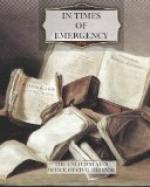—If you are outside in open country, drive away from the tornado’s path, at a right angle to it. If there isn’t time to do this—or if you are walking—take cover and lie flat in the nearest depression, such as a ditch, culvert, excavation, or ravine.
* * * * *
CHAPTER 4
WINTER STORMS
Here is advice that will help you protect yourself and your family against the hazards of winter storms—blizzards, heavy snows, ice storms, freezing rain, or sleet.
* KEEP POSTED ON WEATHER CONDITIONS. Use your radio, television and newspapers to keep informed of current weather conditions and forecasts in your area. Even a few hours’ warning of a storm may enable you to avoid being caught outside in it, or at least be better prepared to cope with it. You should also understand the terms commonly used in weather forecasts:
—A blizzard is the most dangerous of all winter storms. It combines cold air, heavy snow, and strong winds that blow the snow about and may reduce visibility to only a few yards. A blizzard warning is issued when the Weather Bureau expects considerable snow, winds of 35 miles an hour or more, and temperatures of 20 degrees Fahrenheit or lower. A severe blizzard warning means that a very heavy snowfall is expected, with winds of at least 45 miles an hour and temperatures of 10 degrees or lower.
—A heavy snow warning usually means an expected snowfall of 4 inches or more in a 12-hour period, or 6 inches or more in a 24-hour period. Warnings of snow flurries, snow squalls, or blowing and drifting snow are important mainly because visibility may be reduced and roads may become slippery or blocked.
—Freezing rain or freezing drizzle is forecast when expected rain is likely to freeze as soon as it strikes the ground, putting a coating of ice or glaze on roads and everything else that is exposed. If a substantial layer of ice is expected to accumulate from the freezing rain, an ice storm is forecast.
—Sleet is small particles of ice, usually mixed with rain. If enough sleet accumulates on the ground, it will make the roads slippery.
* BE PREPARED FOR ISOLATION AT HOME. If you live in a rural area, make sure you could survive at home for a week or two in case a storm isolated you and made it impossible for you to leave. You should:
—Keep an adequate supply of heating fuel on hand and use it sparingly, as your regular supplies may be curtailed by storm conditions. If necessary, conserve fuel by keeping the house cooler than usual, or by “closing off” some rooms temporarily. Also, have available some kind of emergency heating equipment and fuel so you could keep at least one room of your house warm enough to be livable. This could be a camp stove with fuel, or a supply of wood or coal if you have a fireplace. If your furnace is controlled by a thermostat and your electricity is cut off by a storm, the furnace probably would not operate and you would need emergency heat.




